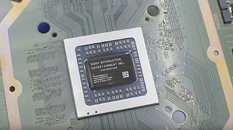Tuesday, June 12th 2018

Sony Closely Associated with AMD "Navi" Development
AMD monetizes its GPU IP not just with discrete graphics cards and integrated graphics in its PC processors, but also by selling semi-custom SoCs for most modern game consoles, such as the Xbox One and PlayStation 4, with some of the newer 4K UHD-capable models such as the PlayStation 4 Pro and Xbox One X even leveraging newer graphics architectures by the company, such as "Polaris." 2020 could see the roll out of next-generation gaming consoles, which are more purpose-built for 4K UHD gaming, with visual fidelity matching gaming PCs, and so console manufacturers are looking for a lean and powerful new GPU IP. Sony seems to have made up its mind of sticking with AMD.
AMD will supply a semi-custom SoC to Sony for its next major console, "PlayStation 5." This chip will feature a graphics processor based on the "Navi" architecture, which succeeds "Vega." 2020 could also be the year when the 7 nm silicon fabrication process achieves some maturity and makes up most of the bulk ASIC production nodes. According to Tweaktown, Sony is closely working with AMD for the development of the "Navi" architecture itself, so versions of it are efficient enough to be deployed in console SoCs that are built to a cost. The design goal will be to enable 4K @ 60 Hz gaming, as 4K televisions will have proliferated a lot by 2020.
Source:
TweakTown
AMD will supply a semi-custom SoC to Sony for its next major console, "PlayStation 5." This chip will feature a graphics processor based on the "Navi" architecture, which succeeds "Vega." 2020 could also be the year when the 7 nm silicon fabrication process achieves some maturity and makes up most of the bulk ASIC production nodes. According to Tweaktown, Sony is closely working with AMD for the development of the "Navi" architecture itself, so versions of it are efficient enough to be deployed in console SoCs that are built to a cost. The design goal will be to enable 4K @ 60 Hz gaming, as 4K televisions will have proliferated a lot by 2020.

48 Comments on Sony Closely Associated with AMD "Navi" Development
Now Freesync on the new Samsung 4K TV's that are coming out make sense for a PS5 console gamer. Smart move by Sony going with AMD to provide the best possible gaming experience by taking advantage of the hardware's standard VESA Freesync capabilities that other GPU's lack.
Next gen consoles should be able to pull it off by 2020. If not, I'll be disappointed only because I know that the bar is raised every time a new wave of consoles comes out. But then again, we PC gamers are always ahead of the hardware curve ;)
Stop funding this 80s trend of closed machines with shitty closed OSs already...
To disable it, you have to turn it off manually, or simply select 'game mode', which will disable it by default, to reduce input lag.
List of all games I'd say it's a rare unicorn indeed, notice how few games support it past 2014-2015.
I can ensure you Physx has been left mostly untouched on consoles for two reasons : firstly, Physx went open source rather late in 2015 and secondly, no sane developer would waste the already sparse CPU cycles for something like this.
My friend had a choice, should he buy a PS4 Pro or a PC. He bought a PS4 pro because for the same price of a GPU that could run 4K @ 30fps, he got a complete system.
Currently, consoles are a good choice because there's a lot of title that runs on it, good exclusivity (for ps4 at least) and great price compared to overpriced PC components because of mining craze.
PC is still the master race in my heart, but right now, you gotta spend alot to join the race so as of gaming, I tend to advice to buy a PS4 instead as it still has some good times ahead.
Classic cost calc mistake.
But you're right if we're speaking of buying a console today; the PS4 has maybe 2 - 3 years left, maybe it's not the right time right now to buy one, except if it's a used one.
I was talking about payment for services and games.
As a PC gamer, you don't pay those 150$ for 3 years of online play, and if you buy games on a regular basis, add a few more hundreds to that.
Paying only 400-500$ initially on the machine gives the illusion of saving money.
For real tho, you make a good point here, I totally forgot the price of PSN and the higher price of the games. In my case, I buy a month or two if I want to play some games online but it rarely happen and you can buy used game if you don't wanna play full price for a game. Might be a better choice for casual?